Performing a router comparison in the industrial space can be daunting. Cellular routers with industrial components have a wide range of features and capabilities. Some are designed for the toughest environments, while others need to be housed in an enclosure, for example. And we can talk about features and “speeds and feeds” all day. How fast do you need data to transfer? Do you need low latency? 5G or 4G LTE? And then there are the connectivity options. Do you need to connect a lot of peripherals? Do you need Wi-Fi? Bluetooth? Does your device need to stay connected on-the-go?
Digi cellular solutions meet the requirement of a vast range of applications across many different industrial verticals — whether the unit will be deployed in the field, a factory, or on a moving train. To help our customers and partners select the right solution for a particular application, we group them into three categories: Enterprise (EX), Industrial (IX) and Transportation (TX). In this blog post, we will compare routers in the Digi IX and Digi TX product lines, as both product families are designed for challenging environments with industrial specifications.
Importantly, these products all have some key features and capabilities in common: they are software-defined solutions, with industry-leading configuration, security and management features that make them easy to deploy, monitor, manage and update — regardless of where you deploy and how many devices you manage. Sophisticated software, paired with cloud-based access and edge management capabilities deliver the critical insights and remote access to fully optimize and manage your deployment.
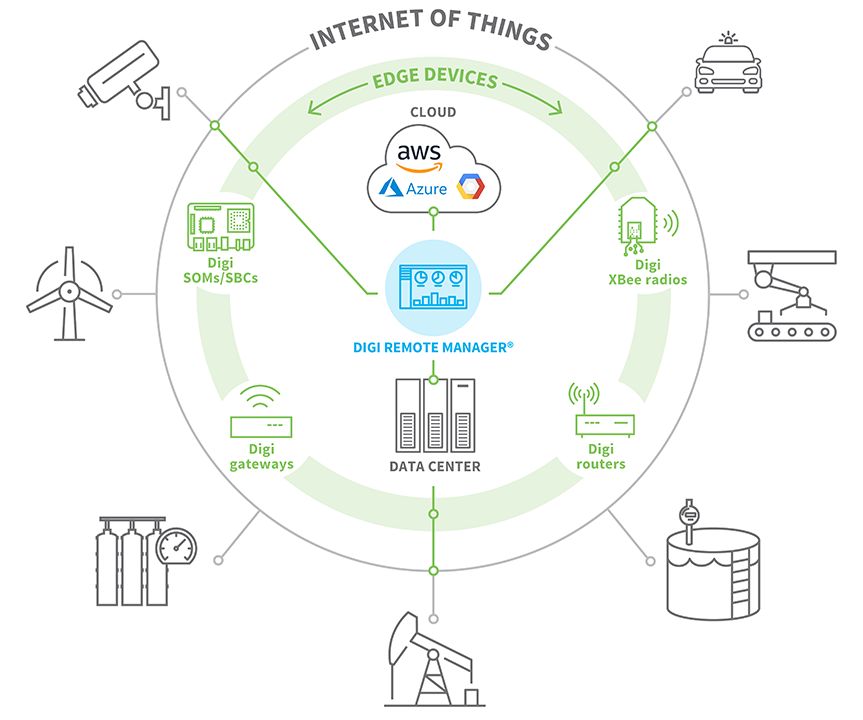
Router Comparison: Industrial and Transportation Solutions
There are several ways to compare router solutions. For example, if you are seeking industrial-rated routers, you can directly compare the options in Digi’s IX (industrial) router family. Or if you are preparing to deploy connectivity solutions for a traffic management or transit application, you could directly compare the purpose-built cellular solutions in Digi’s TX (transportation) router family.
However, since both the IX and TX families have industrial specifications, you may want to evaluate options in both product families.
Using the Router Comparison Tool
First, let’s walk through a high-level method of comparing two or more routers on digi.com. Digi has a fast and easy router comparison tool that lets you quickly evaluate two, three or four routers side-by-side. In this example, we will compare one product from the Industrial router category and one product from the Transportation router category.
To use the tool, simply go to www.digi.com, and then follow these steps:
- Click IoT Products and Services from the top of the Digi home page, then select Cellular Routers from the Networking section.
- Now select a router category from the menu on the right side of the page. For example, we’ll start by selecting the Industrial Routers category.
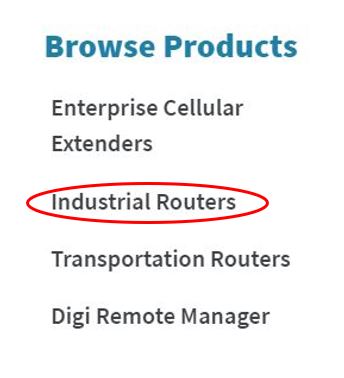
- From the Industrial Routers category page, identify a product you would like to compare and click the Add to Compare link below the product’s description. In the figure, we’ve shown how to select the Digi IX30 industrial cellular router.
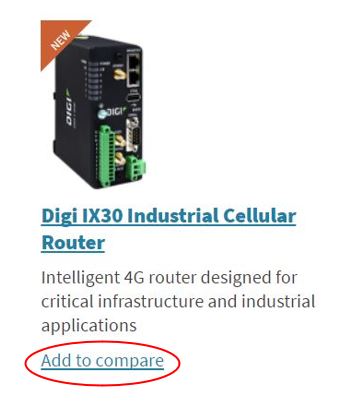
- In the same window, navigate back to the Cellular Routers page using the “bread crumb” bar.

- Now select the Transportation Routers category.
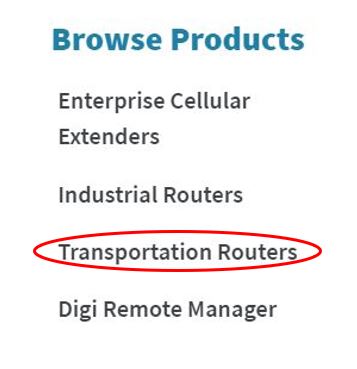
- From the Transportation Routers category page, identify a product you would like to compare and click the Add to Compare link below the product’s description. In the figure, we’ve shown how to select the Digi TX64 5G transportation cellular router.
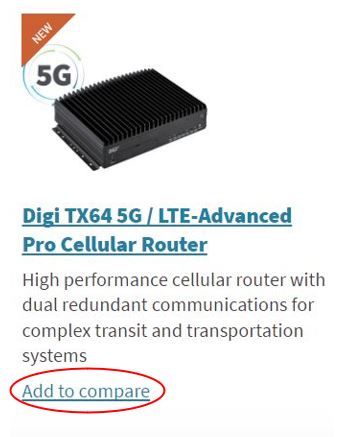
- Now that you have added the Digi IX30 industrial cellular router and the Digi TX64 5G cellular router to the router comparison tool, you will see two selected routers in the upper right corner of the window. Click the Compare button.
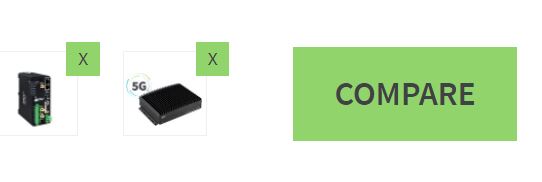
Now you will see a chart that compares ports, networks, interface options, and other key features.
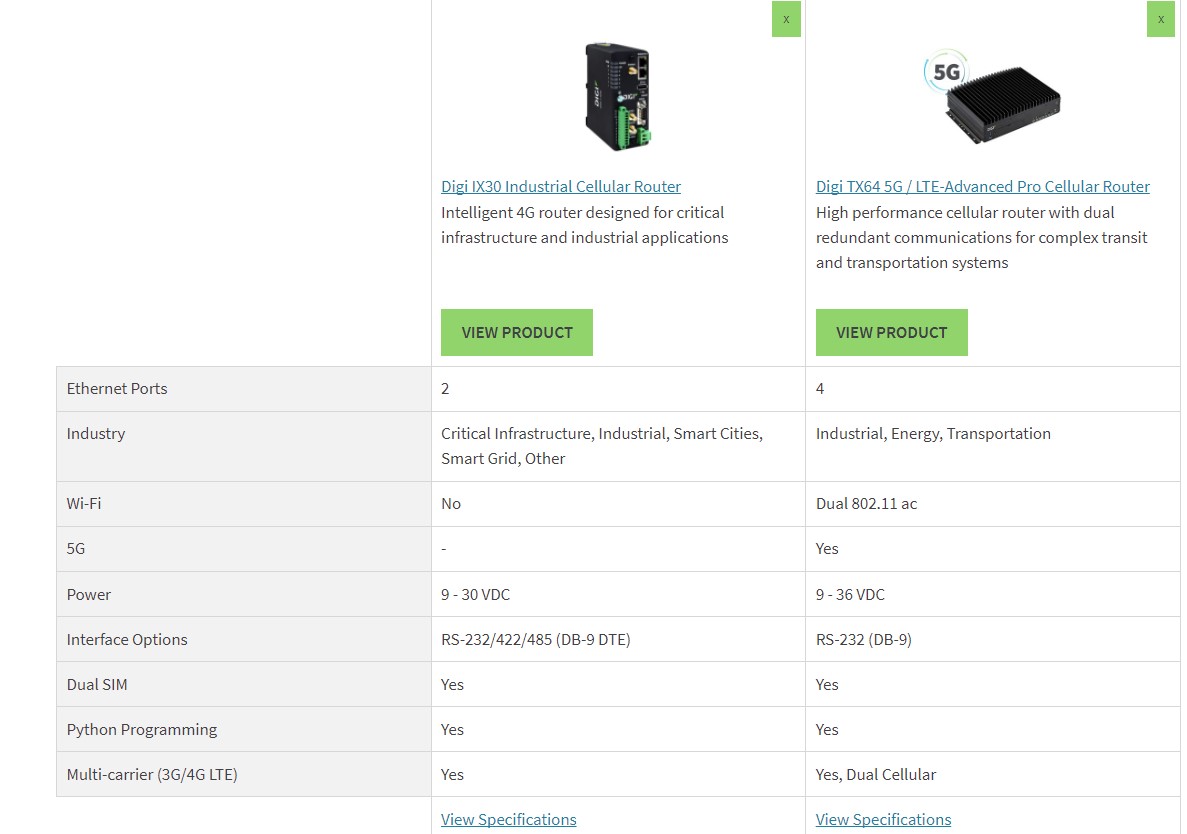
Notice that in this case, in the “Industry” portion of the chart, both of these solutions specify that they are suitable for the Industrial vertical. This is because both routers have industrial specifications.
The next graphic shows a selection of four products added to the comparison tool, including Digi EX50 5G from our Enterprise cellular line, which is appropriate for light industrial environments.
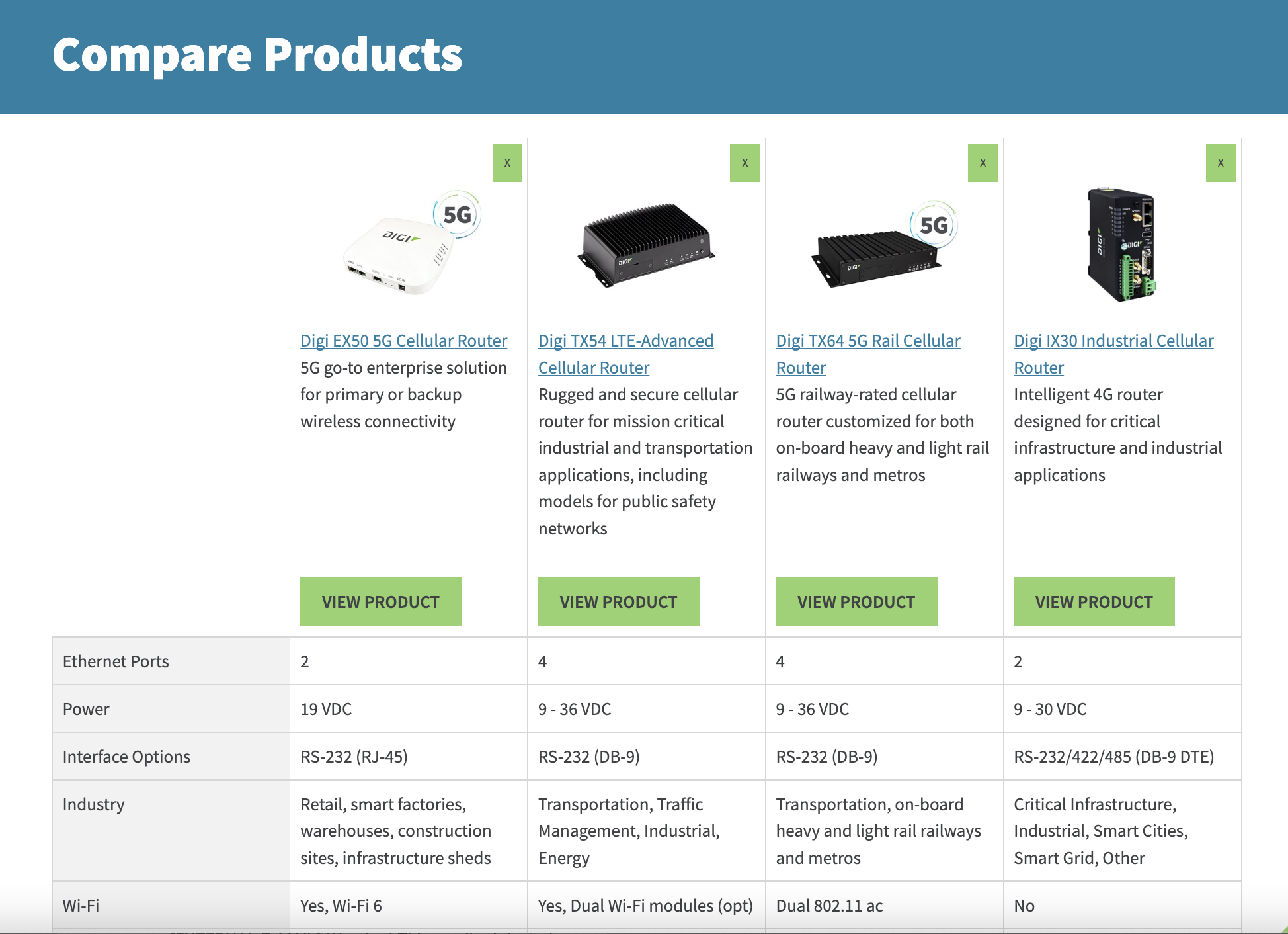
To fully evaluate the right router for your application, you will need to compare the router specifications in more depth. To do so, you can click the View Specifications link beneath each product to view each router’s specifications in more detail.
But how do you know what to look for? As you may expect, the answer is “it depends.” Next we will discuss some starting considerations to help guide you in launching your search for the right solution. If you prefer to consult with a Digi expert, simply contact us to discuss your needs and options.
Comparing Industrial vs. Transportation Router Specifications

Now that you know how to use the comparison tool for direct high-level evaluation of any two-to-four cellular routers at a time, let’s talk about how to compare industrial and transportation router specifications at a deeper level. For this purpose, we will provide a few key considerations that can help you identify the best solution for your needs.
A number of important feature sets distinguish the capabilities of routers in the industrial and transportation industries. We will look at three sets of considerations to support your thinking process:
- Industrial enclosures and ratings
- Stationary and mobile communications
- Network and connectivity options
Industrial enclosures and ratings
Connected devices designed for industrial use cases have a range of ratings, which involve specific testing and certifications. When evaluating the right router for your use case, consider the potential environmental conditions under which the device must operate. Let’s look at examples.
Note: Digi maintains a database of certifications by product. You can peruse Digi certifications here.
Devices for harsh environments
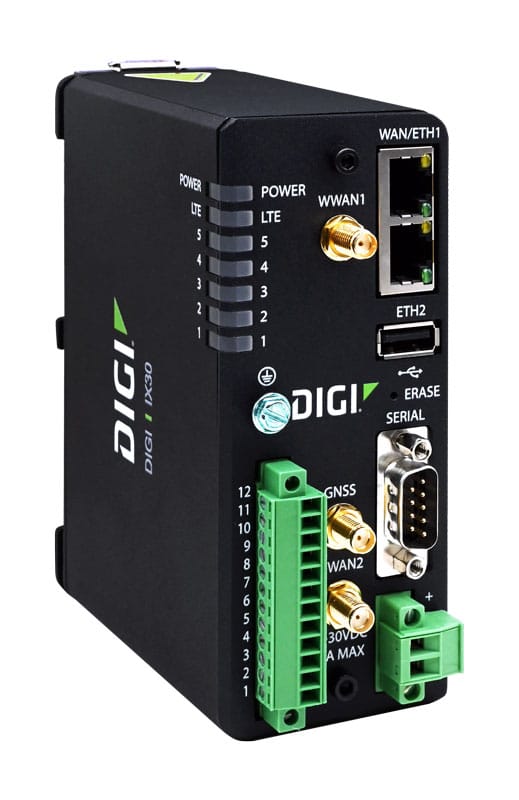
Digi’s newest industrial-rated cellular router, Digi IX30, is rated for harsh conditions, and has been tested to perform at a wide temperature range of -34° C to 74° C (-29° F to 165° F). Its C1D2 (Classification 1, Division 2) classification means it is designed to handle extreme heat and use near flammable substances. This means Digi IX30 is the right choice for heavy industry and critical infrastructure projects such as utilities, municipal lighting, oil and gas, and management of hazardous substances.
Devices for moderate industrial environments
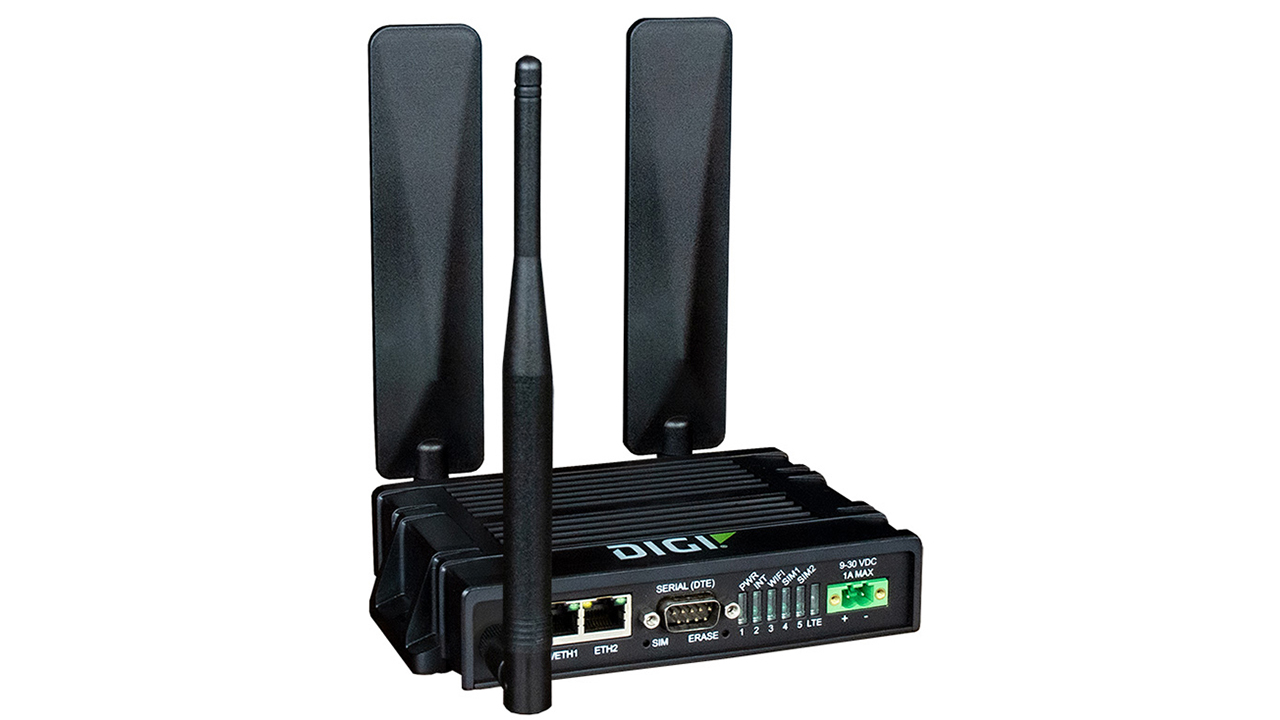
By contrast, if your application does not involve extreme conditions, a router with industrial specifications that is not classified for hazardous conditions may be more suitable and cost-effective. For example, Digi IX20 is designed for challenging environments such as digital signage, agriculture, and other industrial applications. Two models have separate temperature ratings. Wi-Fi models are rated -20° C to 70° C (-4° F to 158° F). Models without Wi-Fi are rated -40° C to 70° C (-40° F to 158° F).
Devices for light industrial environments
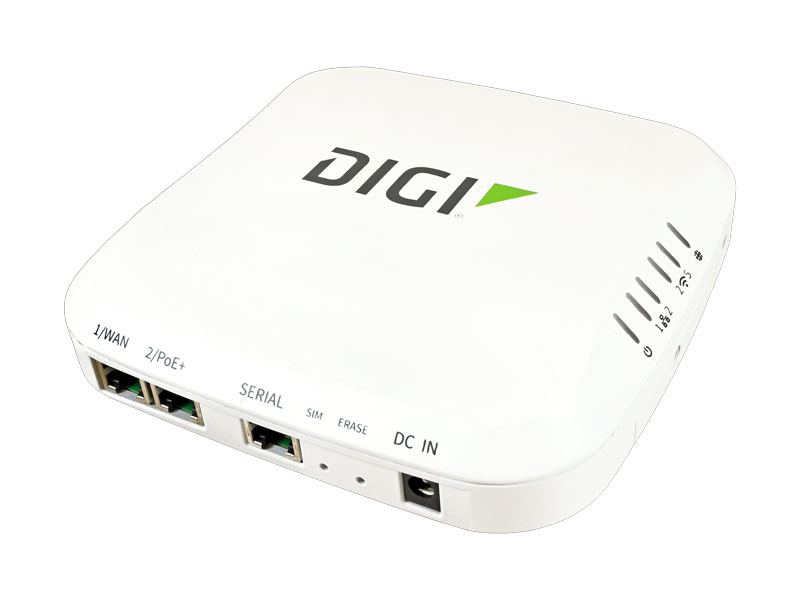
In use cases such as manufacturing and warehousing, where conditions can vary but do not experience extremes, enterprises have several excellent choices. For example, Digi IX10 has excellent industrial specs for light industrial, and is a very cost-effective choice.
It is important to note that there is also cross-over into the light industrial space from our Enterprise (EX) product line with Digi EX50 5G, a 5G cellular router with Wi-Fi 6 that is designed to support extended temperature ranges. Two power options exist for Digi EX50 5G depending upon temperature requirements.
With the included commercial-rated power supply, the device is rated 0° C to 40° C (32° F to 104° F). With Power over Ethernet or industrial-rated power supply, the device is rated -30° C to 60° C (-22° F to 140° F).
Devices for transportation applications
Transportation use cases today are broad, and include traffic management in city centers, public transportation, light rail systems and heavy commercial railways. These environments require connected devices with enclosures and specifications that can handle a range of conditions, including heat, moisture, and vibration.
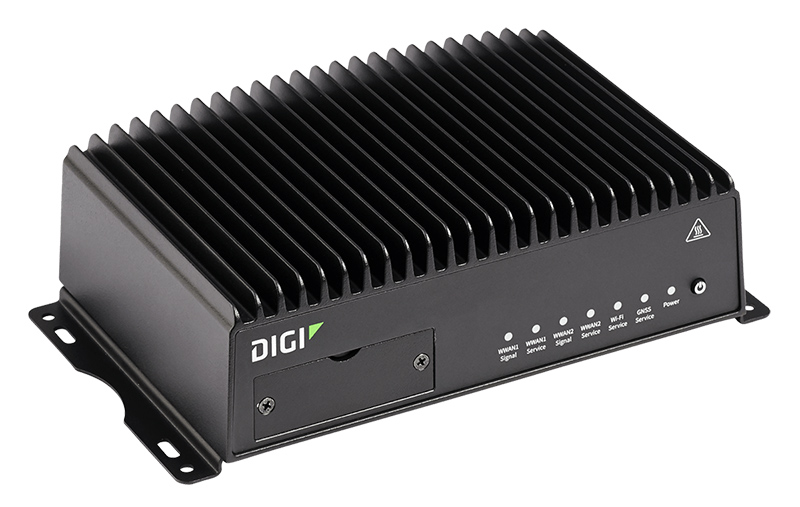
For this reason, Digi’s transportation routers have specific industrial ratings. Digi TX54, for example, has an IP54 rated enclosure and an excellent temperature range of -34° C to 74° C (-29° F to 165° F), making it an ideal solution for traffic management applications. These devices are housed in traffic boxes that offer a layer of protection but must be hardened for moisture and challenging temperatures.
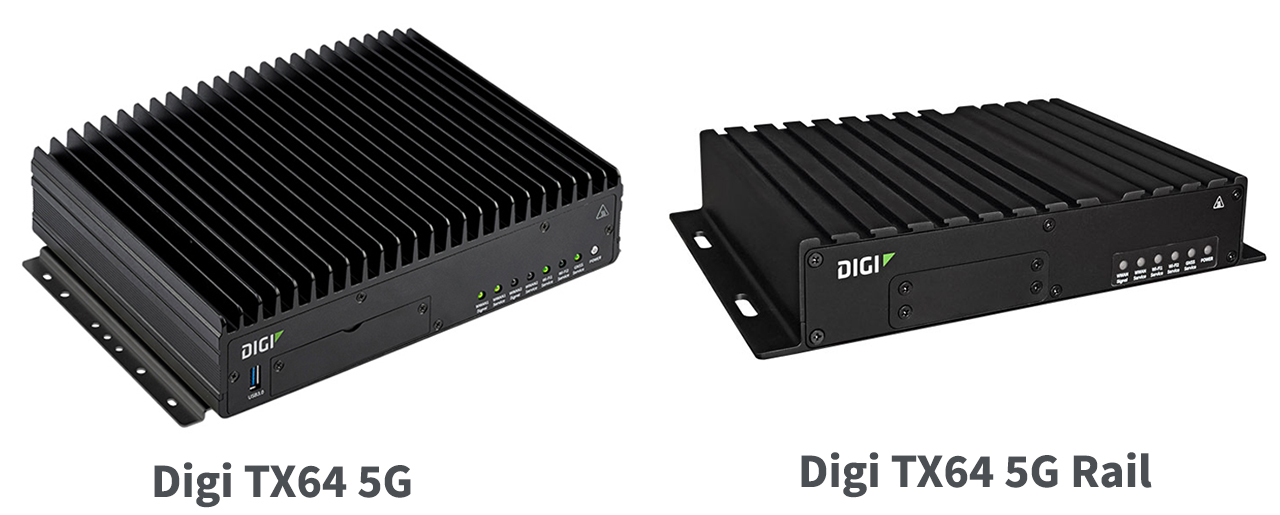
Digi TX64 5G and TX64 5G Rail have MIL-STD 810G rating for temperature, humidity, vibration, shock, and dust, and an operating temperature range of -30° C to 70° C (-22° F to 158° F) for Digi TX64 5G and -34° C to 74° C (-29.2° F to 165.2° F) for Digi TX64 5G Rail, making these highly robust for the challenging conditions of buses, trains, and other vehicles.
Stationary and Mobile Communications
Another key comparison of industrial and transportation routers is whether the device will be installed in a stationary location somewhere on a site or will need mobile connectivity.
Devices used for mobile, mission-critical applications such as public transportation, railway connectivity, and emergency response have special requirements for reliability and uptime while in transit, regardless of their location. They must remain connected on-the-go across networks and regardless of the carrier presence in any one location.
Digi has cellular solutions specifically designed for mobile connectivity, as well as rugged, highly reliable solutions for supporting infrastructure in fleets and transportation systems. In addition to dual-cellular connections, devices supporting mission-critical services are certified for use on the FirstNet® network to ensure communications continue, even in the event of a public emergency.
Mobile vehicle communications
Digi TX64 5G is a next-generation solution purpose-built for buses, paratransit vans and other mobile fleets. This high-performance 5G solution with 4G LTE-Advanced Pro and 3G fallback offers multi-carrier connectivity with dual-cellular communication modules.
It also provides integrated security and VPN, as well as public and private data segmentation to support both system security and passenger Wi-Fi. Additionally, TX64 5G provides untethered dead reckoning GNSS for positioning in remote areas and urban canyons, and is FirstNet Trusted™ for pre-emptive communications on FirstNet® networks.
Light rail and commercial railway communications
Digi TX64 5G Rail is a 5G-native solution with railway ratings for light-rail and heavy commercial rail. It includes all of the great features of Digi TX64 5G, described above, and is also railway certified.
Transit authority and wayside communications
While these communication systems do not require mobility, as they are installed in transit authority buildings, terminals, electric bus charging stations and wayside cabinets, they do require industrial specifications and relentless reliability for challenging environments. Digi IX30, as we’ve discussed, is a hardened cellular router solution with excellent industrial and hazardous environment ratings and is ideal for supporting transportation infrastructure.
The following table provides an overview of some key features of a range of routers. Here you can see that the Digi transportation routers (Digi TX54 and Digi TX64 5G) that are designed for full carrier redundancy and mobile communications have dual-cellular support for this purpose.
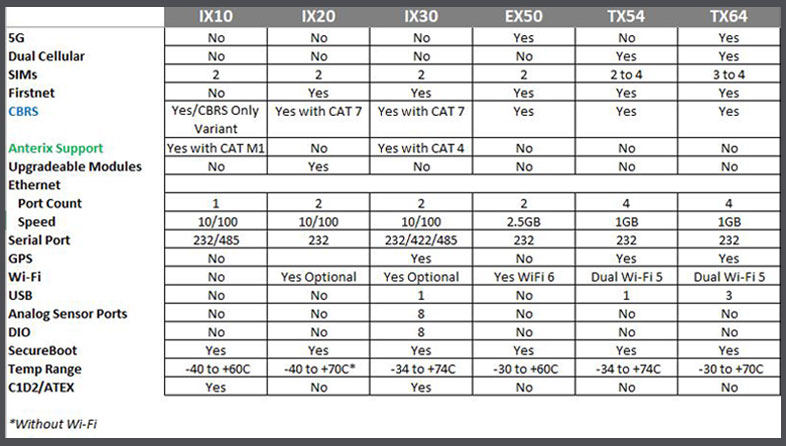
Network and Connectivity Options
In our final router comparison, we’ll look at the types of connectivity enterprises may want to evaluate in an industrial or transportation router to suit their use case and requirements.
5G vs. 4G LTE
As we all know, 5G is the 5th generation network technology, and it is rolling out globally. Meanwhile, as we have discussed in many of our blog posts, including LTE vs. 5G: What Is the Difference?, 4G LTE is going to be available for a very long time. What this means for decision makers deploying connected devices is that both 4G LTE and 5G devices are great choices, and it’s a matter of whether you need the speed and low latency 5G offers.
If you are preparing to deploy in a transportation use case, an industrial setting or challenging environment, we recommend using the router comparison tool described in the first section to compare the key features of both 5G and 4G LTE devices — such as Digi TX54, Digi IX30 and Digi TX64 5G — to assess which solution meets your needs.
Bluetooth
Some applications demand Bluetooth connectivity, and others don’t. It might surprise many to know that Bluetooth, in its variations, is a standard that is needed in several key transportation and industrial use cases. For example, the emerging use of connected vehicles in smart cities relies on identifying pedestrians, bicyclists and vehicles in intersections via Wi-Fi detection, enabled by Bluetooth. For this reason, the Digi TX54 transportation router supports Bluetooth Low Energy (BLE) 4.2.
Similarly, on-the-go vehicles, buses and trains utilize Bluetooth connectivity for integration with smart devices for monitoring and management of IoT systems. You’ll find Bluetooth 5 in the specifications for Digi TX64 5G and Digi TX64 5G Rail for this reason.
Wi-Fi
The Wi-Fi standard is ubiquitous and critical to many different applications today. But different use cases have varying requirements in the industrial and transportation verticals. Today Wi-Fi 5 (802.11ac technology) is the most prevalent Wi-Fi standard, with Wi-Fi 6 (802.11ax emerging as the next generation, and Wi-Fi 7 on the horizon.
Digi’s industrial and transportation solutions primarily support Wi-Fi 5 today. Digi EX50 5G, our enterprise solution with an extended temperature range for light industrial applications, is our first Wi-Fi 6 IoT solution.
Private networks
What if you are deploying in an area that has limited cellular connectivity and Wi-Fi connections are impractical? Today, private networks enable enterprises and industrial operations to establish secure connectivity for a specific remote or isolated area and get needed connectivity over cellular, with CBRS (Citizens Band Radio Service) being one available method. The following diagram shows Digi’s private cellular options, arranged by cost and performance. For more information, see our page, Private LTE Based on CBRS.
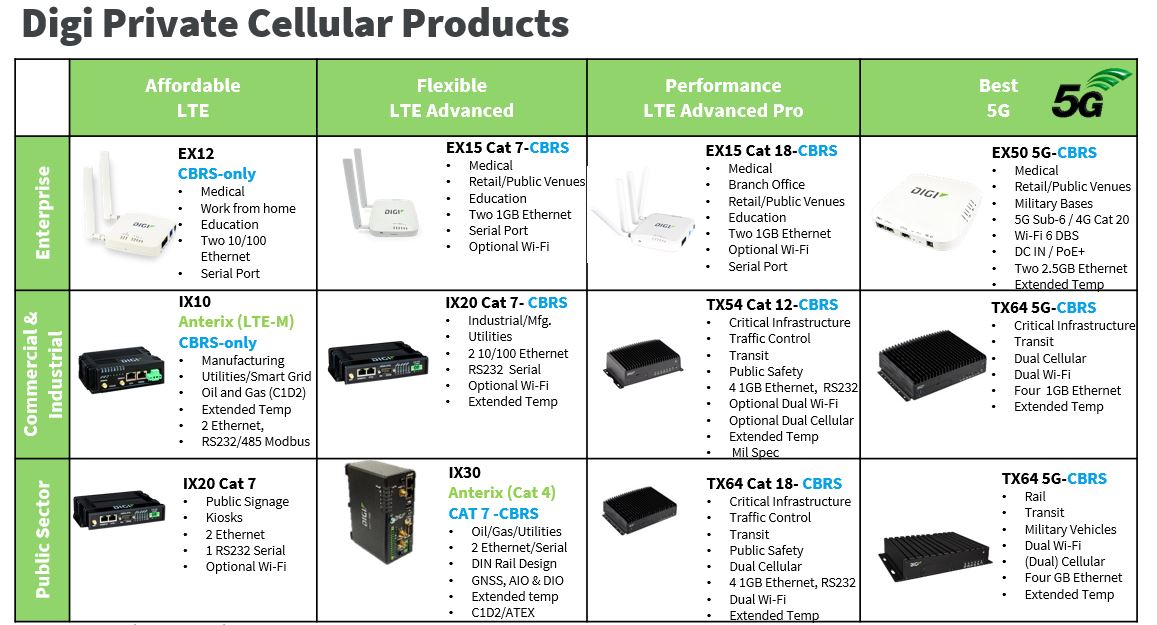
Summary
Comparing industrial and transportation routers is a very worthwhile endeavor when evaluating the right solutions for any use case in which connectivity, environmental and mobility factors are of mission critical importance.
Digi enables side-by-side router comparisons for a high-level review of relevant features, with the ability to quickly dive into additional specifications for a deeper evaluation.
Digi industrial and transportation solutions integrate sophisticated software, security and management tools for rapid configuration and deployment, ongoing security, monitoring and management, as well as the ability to keep devices up-to-date and secure across their entire lifecycle.
Additionally, Digi offers services to support your deployment-readiness to ensure your project goes smoothly, so you complete your project on time and in budget.
Next Steps